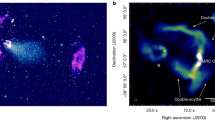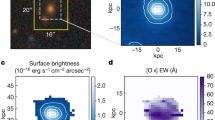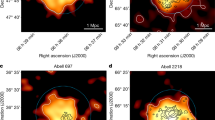Abstract
EXTRAGALACTIC radio sources with extended emission on only one side of the active galaxy usually have very dominant radio cores1–5, large misalignments between the structure inferred from Very Long Baseline Interferometry and that on the arcsecond scale1,6,7, and often evidence of 'blazar' characteristics and superluminal motion in the nucleus8. These properties are usually attributed to relativistic motion of nuclear jets in sources inclined at small angles to the line of sight. From a large survey of possible one-sided sources made with both MERLIN and the Very Large Array, we have been able to identify a class of one-sided sources that are dominated by their extended emission while the lower limits on their degree of asymmetry, inferred from our MERLIN observations, are amongst the highest known. These weak-cored one-sided sources appear to be inconsistent with the 'unified scheme9–15, which attempts to explain core-dominated sources as being the relativistically beamed counterparts of the lobe-dominated ones. We discuss possible explanations for this class of sources and suggest tests to distinguish between the different alternatives.
This is a preview of subscription content, access via your institution
Access options
Subscribe to this journal
Receive 51 print issues and online access
$199.00 per year
only $3.90 per issue
Buy this article
- Purchase on Springer Link
- Instant access to full article PDF
Prices may be subject to local taxes which are calculated during checkout
Similar content being viewed by others
References
Readhead, A. C. S., Cohen, M. H., Pearson, T. J. & Wilkinson, P. N. Nature 276, 768–771 (1978).
Kapahi, V. K. J. Astrophys. Astr. 2, 43–58 (1981).
Moore, P. K., Browne, I. W. A., Daintree, E. J., Noble, R. G. & Walsh, D. Mon. Not. R. astr Soc. 197, 325–337 (1981).
Perley, R. A., Fomalont, E. B. & Johnston, K. J. Astrophys. J. 255, L93–L97 (1982).
O'Dea, C. P., Barvainis, R. & Challis, P. M. Astr. J. 96, 435–454 (1988).
Davis, R. J., Stannard, D. & Conway, R. G. Mon. Not. R. astr. Soc. 185, 435–440 (1978).
Readhead, A. C. S., Hough, D. H., Ewing, M. S., Walker, R. C. & Romney, J. D. Astrophys. J. 265, 107–131 (1983).
Zensus, J. A. & Pearson, T. J. (eds) Superluminal Radio Sources (Cambridge Univ. Press, 1987).
Blandford, R. D. & Rees, M. J. in Pittsburgh Conference on BL Lac objects (ed. Wolfe, A. M.) 328–347 (Univ. of Pittsburgh, 1978).
Scheuer, P. A. G. & Readhead, A. C. S. Nature 277, 182–185 (1979).
Blandford, R. D. & Königl, A. Astrophys. J. 232, 34–48 (1979).
Orr, M. J. L. & Browne, I. W. A. Mon. Not. R. astr. Soc. 200, 1067–1080 (1982).
Kapahi, V. K. & Saikia, D. J. J. Astrophys. Astr. 3, 465–483 (1982).
Antonucci, R. R. J. & Ulvestad, J. S. Astrophys. J. 294, 158–182 (1985).
Barthel, P. D. Astrophys. J. 336, 606–611 (1989).
Miley, G. K. Mon. Not. R. astr. Soc. 152, 477–490 (1971).
Murphy, D. thesis, Univ. of Manchester (1988).
Browne, I. W. A. in Superluminal Radio Sources (eds Zensus, J. A. & Pearson, T. J.) 129–147 (Cambridge Univ. Press, 1987).
Davis, R. J., Muxlow, T. W. B. & Conway, R. G. Nature 318, 343–345 (1985).
Barthel, P. D., Miley, G. K., Schilizzi, R. T. & Lonsdale, C. J. Astr. Astrophys. Suppl. 73, 515–547 (1988).
Owen, F. N. & Puschell, J. J. Astr. J. 89, 932–957 (1984).
Hintzen, P., Ulvestad, J. & Owen, F. Astr. J. 88, 709–758 (1983).
Swarup, G., Sinha, R. P. & Hilldrup, K. Mon. Not. R. astr. Soc. 208, 813–843 (1984).
Laing, R. A., Riley, J. M. & Longair, M. S. Mon. Not. R. astr. Soc. 204, 151–187 (1983).
Laing, R. A. Nature 331, 149–151 (1988).
Garrington, S. T., Leahy, J. P., Conway, R. G. & Laing, R. A. Nature 331, 147–149 (1988).
Rudnick, L. & Edgar, B. K. Astrophys. J. 279, 74–85 (1984).
Saikia, D. J. & Shastri, P. Mon. Not. R. astr. Soc. 211, 47–56 (1984).
Jackson, N., Browne, I. W. A., Murphy, D. & Saikia, D. J. Nature 338, 485–487 (1989).
Author information
Authors and Affiliations
Rights and permissions
About this article
Cite this article
Saikia, D., Junor, W., Muxlow, T. et al. A new class of extragalactic radio sources with one-sided structure?. Nature 339, 286–288 (1989). https://doi.org/10.1038/339286a0
Received:
Accepted:
Issue Date:
DOI: https://doi.org/10.1038/339286a0
This article is cited by
-
Jets in radio galaxies and quasars: an observational perspective
Journal of Astrophysics and Astronomy (2022)
Comments
By submitting a comment you agree to abide by our Terms and Community Guidelines. If you find something abusive or that does not comply with our terms or guidelines please flag it as inappropriate.



